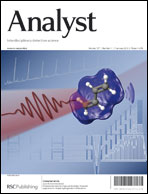Production of monoclonal antibodies against fullerene C60 and development of a fullerene enzyme immunoassay†
Abstract
The aim of the present study was to produce monoclonal anti-fullerene C60 antibodies and to develop the enzyme immunoassay for the detection in the first use of free


 Please wait while we load your content...
Please wait while we load your content...